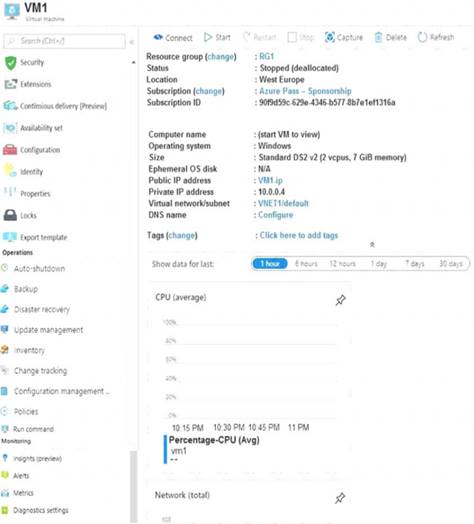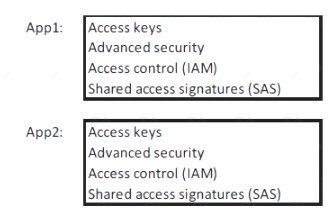- (Exam Topic 6)
You have an Azure subscription named Subscription1. Subscription1 contains the resource groups in the following table.
RG1 has a web app named WebApp1. WebApp1 is located in West Europe.
You move WebApp1 to RG2. What is the effect of the move?
Correct Answer:C
You can move an app to another App Service plan, as long as the source plan and the target plan are in the same resource group and geographical region.
The region in which your app runs is the region of the App Service plan it's in. However, you cannot change an App Service plan's region.
References: https://docs.microsoft.com/en-us/azure/app-service/app-service-plan-manage
- (Exam Topic 5)
You have an Azure subscription named Subscription1 that has the following providers registered:  Authorization
Authorization Automation
Automation  Resources
Resources  Compute
Compute  KeyVault
KeyVault  Network
Network Storage
Storage  Billing
Billing  Web
Web
Subscription1 contains an Azure virtual machine named VM1 that has the following con figurations:
* Private IP address: 10.0.0.4 (dynamic)
* Network security group (NSG): NSG1
* Public IP address: None
* Availability set: AVSet
* Subnet: 10.0.0.0/24
* Managed disks: No
* Location: East US
You need to record all the successful and failed connection attempts to VM1.
Which three actions should you perform? Each correct answer presents part of the solution.
NOTE: Each correct selection is worth one point.
Correct Answer:CDE
NSG flow log data is written to an Azure Storage account. You need to create an Azure Storage account, With an Azure Storage account NSG flow logs can be enabled.
Enable network watcher in the East US region.
NSG flow logging requires the Microsoft.Insights provider. References:
https://docs.microsoft.com/en-us/azure/network-watcher/network-watcher-nsg-flow-logging-portal
- (Exam Topic 6)
You have an Azure subscription named Subscription1. Subscription1 contains a virtual machine named VM1. You have a computer named Computer1 that runs Windows 10. Computer1 is connected to the Internet.
You add a network interface named VM1173 to VM1 as shown in the exhibit. (Click the Exhibit tab.)
From Computer1, you attempt to connect to VM1 by using Remote Desktop, but the connection fails.
Correct Answer:C
Note: Rules are processed in priority order, with lower numbers processed before higher numbers, because lower numbers have higher priority. Once traffic matches a rule, processing stops. As a result, any rules that exist with lower priorities (higher numbers) that have the same attributes as rules with higher priorities are not processed.
References: https://docs.microsoft.com/en-us/azure/virtual-network/security-overview
- (Exam Topic 6)
You have an Azure Storage account named storage1.
You have an Azure App Service app named app1 and an app named App2 that runs in an Azure container instance. Each app uses a managed identity.
You need to ensure that App1 and App2 can read blobs from storage1 for the next 30 days. What should you configure in storage1 for each app?
Solution:
With Shared access signature you can limit the resources for access and at the same time can control the duration of the access.
A shared access signature (SAS) provides secure delegated access to resources in your storage account without compromising the security of your data. With a SAS, you have granular control over how a client can access your data. You can control what resources the client may access, what permissions they have on those resources, and how long the SAS is valid, among other parameters.
Reference:
https://docs.microsoft.com/en-us/azure/storage/common/storage-sas-overview
Does this meet the goal?
Correct Answer:A
- (Exam Topic 5)
Note: This question is part of a series of questions that present the same scenario. Each question in the series contains a unique solution that might meet the stated goals. Some question sets might have more than one correct solution, while others might not have a correct solution.
After you answer a question in this section, you will NOT be able to return to it. As a result, these questions will not appear in the review screen.
You have an Azure subscription that contains 10 virtual networks. The virtual networks are hosted in separate resource groups.
Another administrator plans to create several network security groups (NSGs) in the subscription.
You need to ensure that when an NSG is created, it automatically blocks TCP port 8080 between the virtual networks.
Solution: You assign a built-in policy definition to the subscription. Does this meet the goal?
Correct Answer:B
Resource policy definition used by Azure Policy enables you to establish conventions for resources in your organization by describing when the policy is enforced and what effect to take. However, there are no built-in policy definitions. Though there are sample policy defintions.
Reference:
https://docs.microsoft.com/en-us/azure/azure-policy/policy-definition